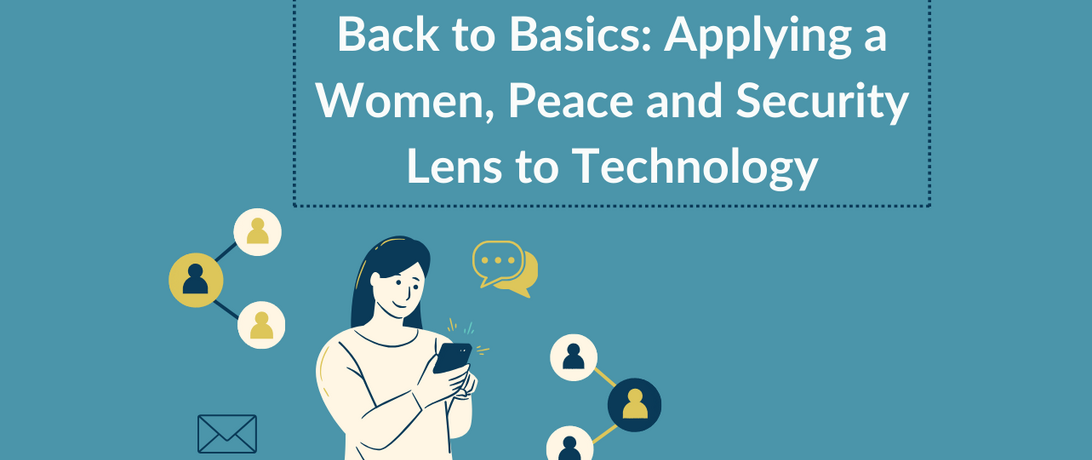
Jessica Maksimov, intern at Our Secure Future, discusses the necessity of incorporating a Women, Peace and Security lens in the digital space to help policymakers identify gender blind spots.
The pervasiveness of technology is growing ever-present with companies and governments integrating artificial intelligence, algorithms, connectivity, cloud computing, among other capabilities. As of July 2023, 65 percent of the world’s population constituted internet users. As the global digital ecosystem grows, the technology’s reflections of existing societal gender inequalities become ingrained in many facets of the digital space. Since women have been largely absent from the technology building and regulatory space, half of the world’s population is neglected from developing and regulating the global digital ecosystem. The online world is amplifying and reflecting existing inequalities in society. Utilizing a Women, Peace and Security lens helps policymakers identify the blind spots that result from inequality.
What is Women, Peace and Security?
WPS stems from the U.N. Security Council Resolution 1325, which was passed unanimously in October 2000. The Resolution establishes an international mandate, requiring the international community and individual governments to support the “full participation of women and to integrate gender analysis into peace and security decision-making.” The WPS agenda promotes “nonviolent, human rights–based approaches to peace and security decision-making” and “acknowledges equality between men and women as intrinsic to achieving lasting peace.” WPS provides a framework for examining gendered dynamics and their implications for peace, prosperity, and security. The strategies used by policy practitioners, security actors, and peacebuilders in promoting WPS include, “increasing the participation of women in decisionmaking and applying gender perspectives to international peace and security matters.”
Why Apply the WPS Framework?
A digital ecosystem that is built by and for men excludes women and marginalized groups from becoming users, regulators, and wielders of the technology. Mainly, when one’s experiences are not represented or accounted for, they are less likely to benefit from or engage with the systems. Firstly, economic gains are diminished when entire groups are excluded from the digital space—which is growing increasingly ubiquitous. When systems exclude groups by failing to account for how they interact with technology and the market, the businesses wielding this technology forgo potential consumers. With a gender lens, businesses can take “the different experiences that women, men, boys, and girls have in varying environments and situations,” resulting in a more profitable market. Secondly, considering people’s experiences with technology more holistically can help policymakers and technology designers eliminate risks or disadvantages posed to various groups, thereby increasing their security. Currently, women face higher rates of harassment on social media; in the US alone, 75 percent of cyberstalking victims are women. They are often targeted by gendered and sexualized disinformation campaigns and express concern that online threats will be actualized in the offline space.
Driving women away from platforms has significant monetary implications for businesses and their earning potential. FP Analytics cites, “Women constitute more than 38 percent of the global labor force and control 32 percent of the world’s wealth, or around $72 trillion. Between 2016 and 2019, women accumulated wealth at a rate of more than 6 percent a year, far outpacing the growth of the broader economy.” Excluding this portion of the global wealth impedes businesses’ bottomline—profit. Overcoming the gender blindspot will therefore have positive implications for businesses and consumers.
Women currently constitute a small minority of technology leadership, design, and deployment. As of 2021, less than 30 percent of women constituted the global technology workforce, 50 percent of technology startups do not have women on their leadership teams, and only 12 percent of leaders in US venture capital firms were women. Additionally, with the advent of AI, it is relevant to consider that only 12 percent of the people working on leading machine learning technology are women. Female underrepresentation in technology development omits their perspectives and contributions, leading to biased technology implemented into all aspects of everyday lives and company practices.
Tech for Positive Change
Although there are reasons for concern with emerging technologies and their implications for women and girls, there have also been positive technological developments, boosting the role of women in society. Firstly, technology can eliminate some barriers to entry for male-dominated skilled work. According to Joseph Fuller, a co-leader of the Harvard Business School’s Managing the Future of Work research program, many existing jobs rely on a workforce that has historically skewed male—allowing more men to develop technical skills. However, with the advent of new technologies, such as machine learning, the importance of having a technical background is becoming less pertinent. Additionally, under the US CHIPS and Science Act, the US government is investing in STEM programs and opportunity, specifically geared at helping “more people from all backgrounds and all regions and communities around the country, especially people from marginalized, under-served, and under-resourced communities” to learn about and engage in the STEM field. Thirdly, education is becoming more accessible for women through online certificates which can boost womens’ abilities to enter the technology field—eventually evening out the skewed statistics discussed above. Finally, the wide-reaching communication space allows women to voice concerns and protests online to subvert patriarchal norms and boost their voices. For instance, in Nigeria, existing technology helped women fight against the patriarchy and gender discrimination through online protests, such as the 2014 #ChildNotBride campaign.
Article Details
Published
Written by
Topic
Program
Content Type
Opinion & Insights